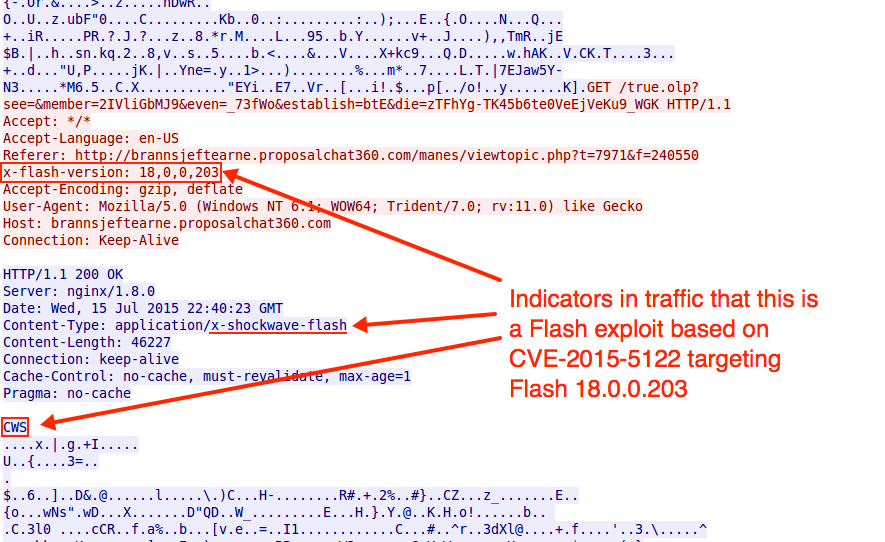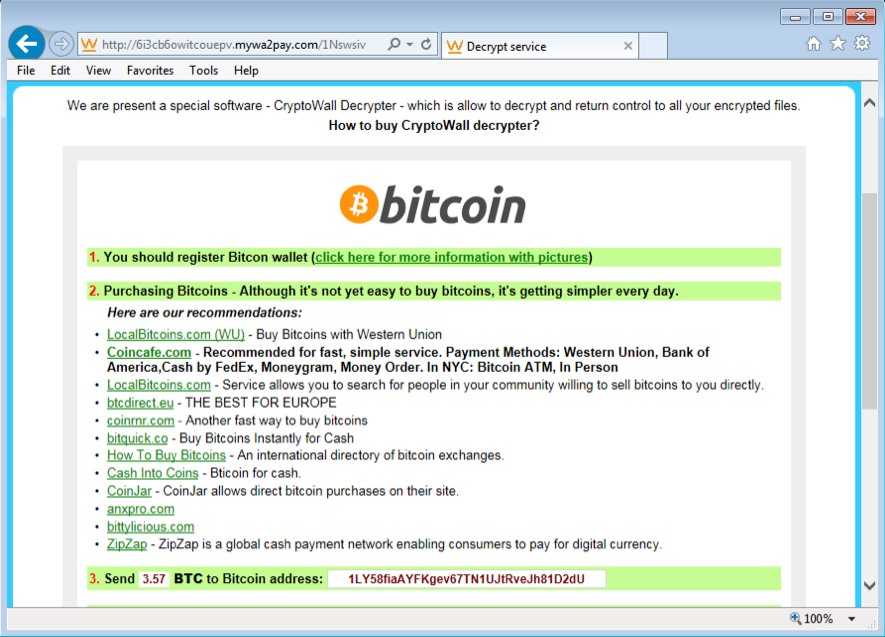After Flash, what will exploit kits focus on next?
Introduction
Adobe has received some bad publicity regarding zero-day Flash player exploits due to the recent Hacking Team compromise [1,2]. This certainly isn't the first time Adobe has had such issues [3]. With HTML5 video as an alternative to Flash player, one might wonder how long Flash player will be relevant. Google has announced the next stable version of Chrome will block auto-playing Flash elements [4], and Firefox started blocklisting Flash player plugins earlier this week [5]. With people like Facebook's chief security officer calling for Adobe to announce an end-of-life date for Flash [6], I've been wondering about the future of Flash player.
More specifically, I've been wondering what exploit kit (EK) authors will turn to, once Flash player is no longer relevant.
In recent months, most EK traffic I've generated used a Flash exploit to infect vulnerable Windows hosts. The situation with Flash player today is much like the situation with the Java that I remember back in 2013 and most of 2014. However, in the fall of 2014, most EKs dropped Java exploits from their arsenal and started relying on Flash player as a vehicle for their most up-to-date exploits.
A recent history Java exploits in EK traffic
Java exploits were prevelant when I first started blogging about EK traffic in 2013 [7]. Back then, Blackhole EK was still a player, and I commonly saw Java exploits in EK traffic.
The threat landscape altered a bit when the EK's alleged creator "Paunch" was arrested. Organizations that monitor EK traffic noticed a sharp reduction of Blackhole EK traffic in 2014 compared to the previous year [8]. During that same time, I started noticing more Flash exploits in EK traffic. By September 2014 most of the remaining EKs stopped using Java.
My last documented dates for Java exploits in exploit kit traffic are below (read: exploit kit name - date Java exploit last seen).
- Angler EK - 2014-09-16 [9]
- FlashPack EK - 2014-08-30 [10]
- Nuclear EK - 2014-09-08 [11]
- Magnitude EK - 2014-08-15 [12]
- Sweet Orange EK - 2014-09-25 [13]
- Rig EK - 2014-09-06 [14]
Of note, FlashPack EK and Sweet Orange EK have disappeared, and they are not currently a concern. Neutrino EK was dormant from April through October of 2014, and when it came back, I didn't see it using any Java exploits.
Fiesta EK still sends several different types of exploits depending on the vulnerable client, and it still has Java exploits in its arsenal. Other lesser-seen EKs like KaiXin still use Java exploits. However, the majority of EKs gave up on Java sometime last year.
What we're recently seeing with Flash exploits
Most exploit kits use the latest available Flash exploits. Angler, Neutrino, Nuclear, Magnitude, and Rig EK are all using the latest Hacking Team Flash player exploit based on CVE-2015-5122 [15]. If you have Flash player on a Windows computer, you should be running the most recent Flash update (version 18.0.0.209 as I'm writing this).
Earlier I generated Angler EK traffic to infect a Windows host running Flash player 18.0.0.203 on IE 11. Angler sent a Flash exploit based on CVE-2015-5122, and the EK sent CryptoWall 3.0 as the malware payload.

Shown above: An image of the Angler EK infection and post-infection CryptoWall 3.0 traffic in Wireshark. Click on the image for a full-size view.

Shown above: Angler EK sending a Flash exploit, based on CVE-2015-5122, targeting Flash 18.0.0.203.
The infected host's bitcoin address for ransom payment was 1LY58fiaAYFKgev67TN1UJtRveJh81D2dU. The address is the same one seen on 2015-07-01 and also documented in my previous diary on CryptoWall 3.0 [16].

Shown above: Decrypt instructions from the infected host.
Final words
Today, the majority of EKs utilize Flash player exploits based on the most recently known vulnerabilities. But this situation can't last forever. If Flash is no longer relevant, what will EK authors turn to for their latest exploits? Will they go back to Java? Will they focus on browser vulnerabilities? It will be interesting to see where things stand in the next year or so.
A pcap of the 2015-07-15 Angler EK infection traffic is available at:
A zip file of the associated malware is available at:
The zip file is password-protected with the standard password. If you don't know it, email [email protected] and ask.
---
Brad Duncan
ISC Handler and Security Researcher at Rackspace
Blog: www.malware-traffic-analysis.net - Twitter: @malware_traffic
References:
[1] https://krebsonsecurity.com/2015/07/adobe-to-patch-hacking-teams-flash-zero-day/
[2] http://www.pcworld.com/article/2947312/second-flash-player-zeroday-exploit-found-in-hacking-teams-data.html
[3] http://krebsonsecurity.com/2015/02/yet-another-flash-patch-fixes-zero-day-flaw/
[4] http://arstechnica.co.uk/information-technology/2015/06/google-chrome-will-soon-intelligently-block-auto-playing-flash-ads/
[5] http://arstechnica.com/security/2015/07/firefox-blocklists-flash-player-due-to-unpatched-0-day-vulnerabilities/
[6] https://twitter.com/alexstamos/status/620306643360706561
[7] http://malware-traffic-analysis.net/2013/06/18/index.html
[8] http://www.symantec.com/connect/blogs/six-months-after-blackhole-passing-exploit-kit-torch
[9] http://malware-traffic-analysis.net/2014/09/16/index2.html
[10] http://malware-traffic-analysis.net/2014/08/30/index.html
[11] http://malware-traffic-analysis.net/2014/09/08/index2.html
[12] http://malware-traffic-analysis.net/2014/08/15/index.html
[13] http://malware-traffic-analysis.net/2014/09/25/index.html
[14] http://malware-traffic-analysis.net/2014/09/06/index.html
[15] http://malware.dontneedcoffee.com/2015/07/cve-2015-5122-hackingteam-0d-two-flash.html
[16] https://isc.sans.edu/forums/diary/Another+example+of+Angler+exploit+kit+pushing+CryptoWall+30/19863/


Comments
It's kind of like how Cisco still requires Java for some of their admin tools like the ASA ASDM GUI. Our database activity monitoring console is built heavily in Flash. I know because every time Flash crashes I see those "the plug-in has crashed" messages.
Maybe a new article asking people to list IT tools they use that require either Java or Flash? It would be interesting to see how this impacts IT. It's not like we can remove those plug-ins and still do our jobs.
Anonymous
Jul 16th 2015
1 decade ago
John McCash
Anonymous
Jul 16th 2015
1 decade ago
- CWS is seen for Flash files that use zlib compression.
- ZWS is seen for Flash files that use LZMA compression.
This is similar to seeing PK as the first two ASCII characters for a zip archive.
Anonymous
Jul 16th 2015
1 decade ago
Anonymous
Jul 16th 2015
1 decade ago
Our McAfee/Nitro SIEM uses a flash console. It's bad news having flash on a computer that needs lots of access--zones for flash would be handy.
Anonymous
Jul 16th 2015
1 decade ago
Anonymous
Jul 16th 2015
1 decade ago
Our McAfee/Nitro SIEM uses a flash console. It's bad news having flash on a computer that needs lots of access--zones for flash would be handy.[/quote]
Having done some development in html5, I'd agree that it will be a future target. It's rich, and complex, which often takes us down the path of security woes.
Anonymous
Jul 17th 2015
1 decade ago